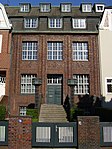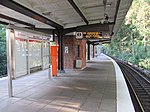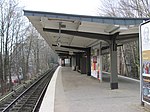Kellinghusenstraße station
1912 establishments in GermanyBuildings and structures in Hamburg-NordHamburg U-Bahn stationsRailway stations opened in 1912

Kellinghusenstraße is a public transport railway station for the rapid transit trains of Hamburg U-Bahn lines U1 and U3. It is located in the Hamburg, Germany quarter of Eppendorf, in the borough of Hamburg-Nord.
Excerpt from the Wikipedia article Kellinghusenstraße station (License: CC BY-SA 3.0, Authors, Images).Kellinghusenstraße station
Loogeplatz, Hamburg Eppendorf (Hamburg-Nord)
Geographical coordinates (GPS) Address External links Nearby Places Show on map
Geographical coordinates (GPS)
| Latitude | Longitude |
|---|---|
| N 53.588888888889 ° | E 9.9911111111111 ° |
Address
Kellinghusenstraße
Loogeplatz
20249 Hamburg, Eppendorf (Hamburg-Nord)
Germany
Open on Google Maps







